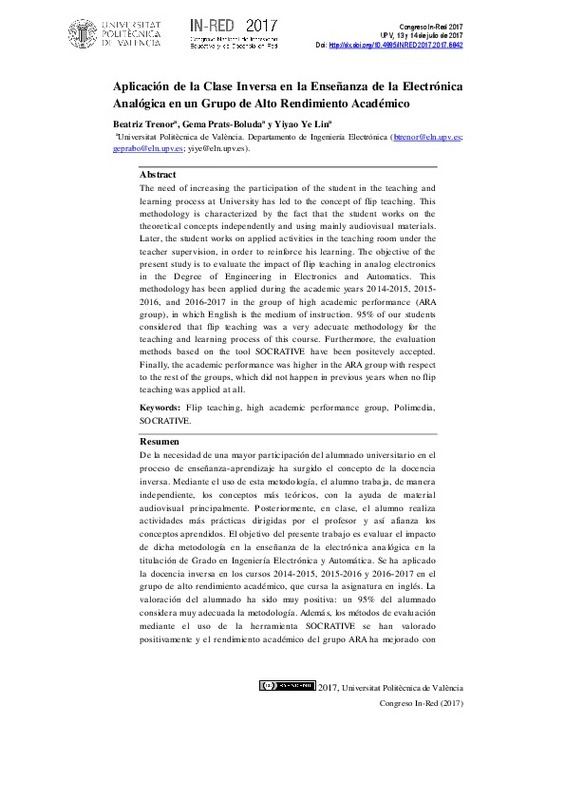JavaScript is disabled for your browser. Some features of this site may not work without it.
Buscar en RiuNet
Listar
Mi cuenta
Estadísticas
Ayuda RiuNet
Admin. UPV
Aplicación de la Clase Inversa en la Enseñanza de la Electrónica Analógica en un Grupo de Alto Rendimiento Académico
Mostrar el registro sencillo del ítem
Ficheros en el ítem
| dc.contributor.author | Trénor Gomis, Beatriz Ana
|
es_ES |
| dc.contributor.author | Prats Boluda, Gema
|
es_ES |
| dc.contributor.author | Ye Lin, Yiyao
|
es_ES |
| dc.date.accessioned | 2018-07-19T07:24:16Z | |
| dc.date.available | 2018-07-19T07:24:16Z | |
| dc.date.issued | 2017-07-18 | |
| dc.identifier.isbn | 9788490485682 | |
| dc.identifier.uri | http://hdl.handle.net/10251/106050 | |
| dc.description.abstract | [EN] The need of increasing the participation of the student in the teaching and learning process at University has led to the concept of flip teaching. This methodology is characterized by the fact that the student works on the theoretical concepts independently and using mainly audiovisual materials. Later, the student works on applied activities in the teaching room under the teacher supervision, in order to reinforce his learning. The objective of the present study is to evaluate the impact of flip teaching in analog electronics in the Degree of Engineering in Electronics and Automatics. This methodology has been applied during the academic years 2014-2015, 2015- 2016, and 2016-2017 in the group of high academic performance (ARA group), in which English is the medium of instruction. 95% of our students considered that flip teaching was a very adecuate methodology for the teaching and learning process of this course. Furthermore, the evaluation methods based on the tool SOCRATIVE have been positevely accepted. Finally, the academic performance was higher in the ARA group with respect to the rest of the groups, which did not happen in previous years when no flip teaching was applied at all. | es_ES |
| dc.description.abstract | [ES] De la necesidad de una mayor participación del alumnado universitario en el proceso de enseñanza-aprendizaje ha surgido el concepto de la docencia inversa. Mediante el uso de esta metodología, el alumno trabaja, de manera independiente, los conceptos más teóricos, con la ayuda de material audiovisual principalmente. Posteriormente, en clase, el alumno realiza actividades más prácticas dirigidas por el profesor y así afianza los conceptos aprendidos. El objetivo del presente trabajo es evaluar el impacto de dicha metodología en la enseñanza de la electrónica analógica en la titulación de Grado en Ingeniería Electrónica y Automática. Se ha aplicado la docencia inversa en los cursos 2014-2015, 2015-2016 y 2016-2017 en el grupo de alto rendimiento académico, que cursa la asignatura en inglés. La valoración del alumnado ha sido muy positiva: un 95% del alumnado considera muy adecuada la metodología. Además, los métodos de evaluación mediante el uso de la herramienta SOCRATIVE se han valorado positivamente y el rendimiento académico del grupo ARA ha mejorado con respecto a los demás grupos, lo cual no sucedió en años anteriores cuando no se aplicaba la docencia inversa. | es_ES |
| dc.format.extent | 12 | es_ES |
| dc.language | Español | es_ES |
| dc.publisher | Editorial Universitat Politècnica de València | es_ES |
| dc.relation.ispartof | In-Red 2017. III Congreso Nacional de innovación educativa y de docencia en red. | es_ES |
| dc.rights | Reconocimiento - No comercial - Sin obra derivada (by-nc-nd) | es_ES |
| dc.subject | Educación superior | es_ES |
| dc.subject | Enseñanza superior | es_ES |
| dc.subject | Tecnologías y educación | es_ES |
| dc.subject | Innovación educativa | es_ES |
| dc.subject | Clase inversa | es_ES |
| dc.subject | Grupo de alto rendimiento académico | es_ES |
| dc.subject | Polimedia | es_ES |
| dc.subject | SOCRATIVE | es_ES |
| dc.subject.classification | TECNOLOGIA ELECTRONICA | es_ES |
| dc.title | Aplicación de la Clase Inversa en la Enseñanza de la Electrónica Analógica en un Grupo de Alto Rendimiento Académico | es_ES |
| dc.type | Capítulo de libro | es_ES |
| dc.type | Comunicación en congreso | es_ES |
| dc.identifier.doi | 10.4995/INRED2017.2017.6842 | |
| dc.rights.accessRights | Abierto | es_ES |
| dc.contributor.affiliation | Universitat Politècnica de València. Departamento de Ingeniería Electrónica - Departament d'Enginyeria Electrònica | es_ES |
| dc.contributor.affiliation | Universitat Politècnica de València. Escuela Técnica Superior de Ingeniería del Diseño - Escola Tècnica Superior d'Enginyeria del Disseny | es_ES |
| dc.contributor.affiliation | Universitat Politècnica de València. Escuela Técnica Superior de Ingenieros Industriales - Escola Tècnica Superior d'Enginyers Industrials | es_ES |
| dc.contributor.affiliation | Universitat Politècnica de València. Centro de Investigación e Innovación en Bioingeniería - Centre de Recerca i Innovació en Bioenginyeria | es_ES |
| dc.description.bibliographicCitation | Trénor Gomis, BA.; Prats Boluda, G.; Ye Lin, Y. (2017). Aplicación de la Clase Inversa en la Enseñanza de la Electrónica Analógica en un Grupo de Alto Rendimiento Académico. En In-Red 2017. III Congreso Nacional de innovación educativa y de docencia en red. Editorial Universitat Politècnica de València. 517-528. https://doi.org/10.4995/INRED2017.2017.6842 | es_ES |
| dc.description.accrualMethod | OCS | es_ES |
| dc.relation.conferencename | IN-RED 2017: III Congreso Nacional de Innovación Educativa y Docencia en Red | es_ES |
| dc.relation.conferencedate | Julio 13-14,2017 | es_ES |
| dc.relation.conferenceplace | Valencia, Spain | es_ES |
| dc.relation.publisherversion | http://ocs.editorial.upv.es/index.php/INRED/INRED2017/paper/view/6842 | es_ES |
| dc.description.upvformatpinicio | 517 | es_ES |
| dc.description.upvformatpfin | 528 | es_ES |
| dc.type.version | info:eu-repo/semantics/publishedVersion | es_ES |
| dc.relation.pasarela | OCS\6842 | es_ES |








